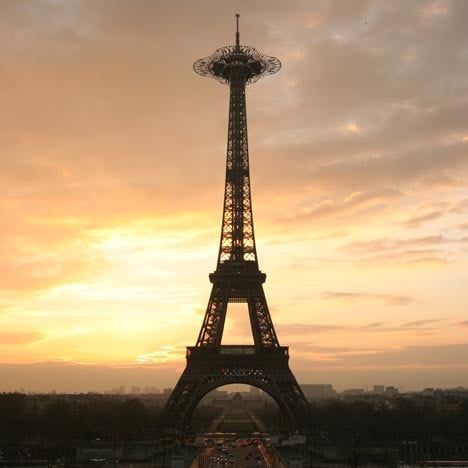Dezeen Book of Ideas: Eiffel DNA by Serero Architects
Every day this week Dezeen editor-in-chief Marcus Fairs is selecting an extract from our Dezeen Book of Ideas. The second project is a competition-winning proposal to add a temporary platform to the Eiffel Tower that turned out to be a fraud.
"I really wanted this project to be real, but unfortunately it's a fake," explains Fairs. "It's an audacious proposal to add a cloud-like Kevlar viewing platform to the top of one of the most famous monuments in the world and it fooled Dezeen along with many other publications. The architects invented the scheme as a publicity stunt, but it's actually quite a beautiful addition to the Eiffel Tower as well as being a good way of relieving the unpleasant crush of visitors at the top of the tower."
"Besides being a salutary warning of the ease with which falsehoods can spread on the web, it's a provocative suggestion of how existing buildings could be adapted in future as new building technologies emerge," he adds. "I spent a couple of years living in Seville in Spain and my favourite building there - in fact one of my favourite buildings anywhere - is the catherdal's Giralda tower. Originally built as a minaret, the austere brick tower was later Catholicised with the addition of a florid Renaissance belfry. The resulting mash-up is as delightful as Serero Architects' Eiffel DNA proposal, suggesting that even the most revered architectural masterpiece might benefit from a makeover."

Eiffel DNA by Serero Architects
This competition-winning design to transform the Eiffel Tower - by adding a flower-like viewing platform at the top - turned out to be a fraud. The project appeared on the website of Serero Architects in March 2008; they claimed to have won a contest to temporarily make over the Parisian landmark to mark its 120th birthday.
Consequently Dezeen, along with several other publications including The Guardian newspaper in the UK, published the seductive images of the iconic tower reimagined by the addition of a Kevlar structure that mimicked the lattice framework of Gustave Eiffel’s 1889 structure.
Called Eiffel DNA, the fantasy project was designed using a generative computer script that identified the tower’s genetic design code and used this template to “grow” a structure that would most efficiently support the temporary platform.
It wasn’t until a few days later that the New York Times established that the competition was non-existent, and we admitted we’d been duped.
The episode was a sobering reminder of the ease with which false information can spread on the internet; but it was also a brilliant PR exercise by the French practice, who received worldwide publicity. We still love the design, too.

Read more about this project on Dezeen
Dezeen Book of Ideas features over 100 fascinating ideas for buildings, products and interiors from the world’s most creative brains.
Reviews of Dezeen Book of Ideas
“From flip-flop art to a mirrored retreat in the sky” – Wall Street Journal
“The Sliding House and The Book of Ideas: Radical Thinking Required” – Forbes.com
“Fairs personally guides readers through the wonders of innovations like a balancing barn, a textile-skinned car, and the first aesthetically pleasing CFL — all of which share an ‘I wish I’d thought of that’ awe factor” – Sight Unseen
“Fabulous” – It’s Nice That
“Totally wonderful!” – Naomi Cleaver
“Handsomely repackages Dezeen’s coverage of the best in architectural, interior and design ideas” – Glasgow Herald
“Teeming with innovative projects handpicked by the people behind Dezeen … readers will be hard-pressed not to find something to gawk over in this intriguing new compendium of beautifully articulated concepts” – Dwell Asia
“Beautifully laid-out, to suit the content, and straight-shooting, non-convoluted descriptions make it user-friendly as well as eye-catching” – Lifestyle Magazine